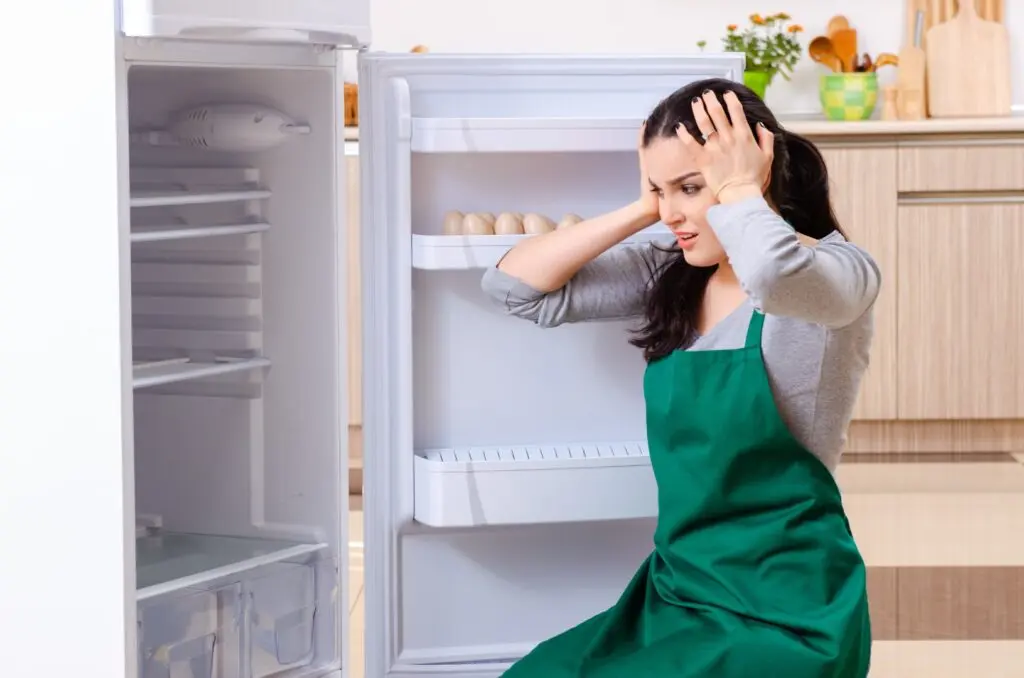When it comes to refrigerator problems, there is more at stake than just a broken appliance. Issues like temperature fluctuations or leakage can lead to food spoilage and even potential water damage to your kitchen floor or cabinetry.
Appliance repair costs can add up quickly, with an average refrigerator repair ranging from $230 to $300. Replacements can be even more expensive, especially when you factor in wasted groceries and kitchen repairs.
No need to stress! Our guide to common refrigerator issues makes it easy to figure out what’s going on with your fridge. With simple DIY fixes, you can tackle the problem head-on, avoid costly repairs, and get your fridge back in working order.
Table of Contents
Common Refrigerator Problems and Ways to Resolve Them
Your refrigerator is one of the most important appliances in your home, working around the clock to keep your food fresh and safe. But like any machine, it can run into issues from time to time. Knowing the most common refrigerator problems can save you from spoiled groceries and costly repairs.
Here are some of the most frequent issues homeowners face with their refrigerators:
-
-
- No power
- Not staying cool
- Water leaks
- Ice buildup
- Constant cycling
-
While this isn’t a comprehensive list, these are the issues you’re most likely to encounter.
Did you know? If you have a home warranty with SHW, repairs for your refrigerator may be covered. Just submit a claim.
Don’t have a home warranty? It all starts with a free quote!
Your Refrigerator Has No Power.
Before tinkering with any settings or parts on your fridge, take a moment to check for any obvious issues.
Step 1: Make sure the refrigerator is plugged in.
This could be an issue if you’ve just moved into a new home or done some recent cleaning. Move the appliance away from the wall and check the outlet to ensure it is plugged in securely. You should also check the power cord for damage. If the power cord is damaged, it will need to be replaced.
Step 2: Inspect circuit breakers in your home.
A tripped breaker could also cause power issues related to your refrigerator. Inspecting the circuit breakers in your home will quickly rule this out as an issue.
Step 3: Check the lights inside your fridge.
If your refrigerator is cool but the interior lights are out, you may just need to replace the bulb. For most models, all you’ll need is a screwdriver and a new light bulb. Check your owner’s manual for the correct wattage.
Your Refrigerator or Freezer isn’t Staying Cool.
Temperature issues are among the most common refrigerator problems, often caused by simple factors like blocked vents or dirty condenser coils. These fluctuations are usually easy to troubleshoot and fix.
Step 1: Check temperature settings.
If you notice condensation or food going bad quickly, the first thing you should do is check your temperature settings. Your refrigerator should be set to 40° F or lower, while your freezer should be at 0° F (FDA).
Step 2: Leave space around your refrigerator.
Bad airflow also contributes to changing temperatures inside your refrigerator. Make sure you leave at least one-quarter inch of space on the sides of your fridge and at least one inch around the top and back. This will ensure enough space for airflow from external vents.
Step 3: Make sure the vents are clear.
Clear items away from internal vents to allow for proper circulation of cold air. We all want to keep our fridges packed, but blocking vents can lead to higher temperatures, which are not good for keeping foods fresh.
Here are some helpful cleaning tips for the inside of your refrigerator.
Step 4: Check the refrigerator door seal.
A broken or weak door seal contributes to temperature changes in your refrigerator. If you find your refrigerator doors aren’t closing properly, replacing the seal will solve this issue.
Step 5: Clean the condenser coils.
The condenser can be found at the back or near the bottom of your fridge, depending on the brand. If the coils get too dusty, they have trouble releasing heat. This leads to higher temperatures inside your fridge.
Be sure to unplug the power supply. Next, use a brush and vacuum to get rid of excess dust and debris.
Reminder: Home warranty coverage can help when it comes to repairs and parts replacements. We’ll send a professional to diagnose your issue quickly. Call 800-670-8931 to get started.
Water Leaks From Your Refrigerator.
A leaking fridge is one of those refrigerator problems that no one wants to handle. If your refrigerator is leaking, there are several components you should check to identify the issue.
Step 1: Unclog the defrost drain.
The defrost drain is located in the rear panel of your freezer. This drain can become clogged or frozen.
-
- In the case that it is clogged, clear away any debris that is blocking the drain.
- If the defrost drain is frozen, flush it with warm water to melt away ice buildup.
Step 2: Check the water filter connection.
Most modern refrigerators are connected to water lines that supply filtered drinking water. Problems with the connection to the water line can cause leaking. Make sure that the line is connected properly and the seal or housing isn’t cracked. These parts can be replaced if they are broken.
Step 3: Replace the drain pan.
A cracked or damaged drain pan can cause water to leak from your refrigerator, potentially creating puddles on your kitchen floor. If you notice this issue, check the drain pan, which is usually located at the bottom of the fridge in most models. If it’s cracked, replacing it can prevent further leaks and damage.
Leaking water can also be a sign that your refrigerator is dying.
Ice Builds up in Your Freezer.
Noticing ice accumulating in your freezer? Some of the same steps used to fix cooling issues may help:
-
- Check the freezer temperature – Ensure it’s set to the recommended level (typically around 0°F).
- Inspect the door seals – Damaged or loose seals can let warm air in, causing frost buildup.
- Clear the vents – Blocked vents restrict airflow, leading to uneven cooling and ice formation.
If these quick fixes don’t solve the problem, there are additional DIY solutions to consider before calling a professional.
Step 1: Defrost your freezer.
Removing your food from the freezer and turning it off to let ice melt can solve this kind of issue. Many manufacturers recommend a yearly defrost to prevent ice buildup from happening.
Step 2: Clean the ice maker damper door.
Your ice maker has a damper door that allows ice to fall down into a collection area. When this door gets dirty, debris causes it to not close properly, which in turn allows frost to build up. Cleaning the damper door can easily solve this issue.
Have trouble with your ice maker? Check out our ice maker troubleshooting guide.
Your Refrigerator Constantly Cycles.
Your refrigerator should be turning on and off throughout the day; this means it is functioning normally. If you hear fans and motors constantly running, you have a problem that needs to be addressed.
Step 1: Readjust your temperature settings.
If there is constant noise from your fridge, the temperature may be set too low. This will cause components to work harder than necessary. Make sure you have your fridge and freezer set to the correct temperatures.
Step 2: Clean the condenser coils.
As with a refrigerator that doesn’t stay cool, dirty condenser coils may cause constant cycling. Keep the condenser coils clean to avoid temperature issues and component problems.
Does a home warranty cover refrigerator Issues?
Yes, a home warranty typically covers refrigerators, including built-in ice makers. With proper maintenance, your refrigerator can last up to 20 years, and a home warranty helps you reach that milestone.
Refrigerator problems can lead to costly repairs, but with a home appliance warranty, those expenses are manageable. Explore our plans to find the right coverage for your home. Get a free quote online or call us today at 860-288-4791.

